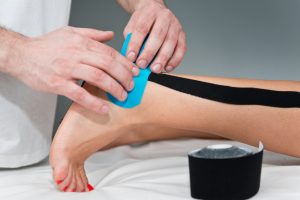If you’ve got a sore, achy knee, you may think a brace, strap or athletic tape will alleviate the pain while you run or participate in your favorite athletic activity.
Depending on your diagnosis, these supportive devices can sometimes help. So what are the options available to you? Read on to learn more about the variety of braces, straps, and tape on the market today.
Straps for Sore Knees
Straps are band-like devices that wrap around the bottom or top of your knee. The strap helps take stress — and therefore pain — off of the patellar tendon at the bottom of the knee. Straps placed above the knee can reduce stress where the IT band becomes tight and creates friction around the knee. Straps can also have a proprioceptive effect on the knee joint. That means the straps makes the brain aware that the muscles around the knee need more support.
Straps are commonly used for:
- Patellar tendonitis,
- Runner’s knee,
- Chondromalacia,
- Patellofemoral pain syndrome,
- IT band friction syndrome.
Braces for Sore Knees
Braces are used in a variety of ways among athletes. They are used after surgery to prevent certain movements during recovery. Others are used to prevent injuries or to provide support and comfort during athletic activities.
The two most popular braces are the knee sleeve and the patella brace. The sleeve provides compression which helps alleviate swelling around the knee and keeps blood flowing to the quadricep muscles that support the knee. The patella brace keeps the kneecap in place during exercise.
Compressive sleeves are used for bruised knees, mild arthritis, runner’s knee or minor sprains. The patella brace is frequently used for conditions like:
- Chondromalacia
- Patellar hypermobility
- Following surgery
Kinesio Tape
You may have seen athletes wearing brightly colored tape that’s called kinesio tape or K-tape. This tape is quite different from traditional athletic tape. K-tape is elastic, like human skin. Therefore, athletes maintain a full range of motion while still receiving therapeutic benefits. K-tape can:
- Reduce the function of overactive muscles
- Increase the contraction of underactive muscles
- Reduce swelling
- Enhance proprioception
Many websites offer guidance on applying K-tape, but appropriate application depends in large part on the specific injury. That’s why it’s best to let an orthopedic specialist teach you the best way to use it. K-tape is used to treat orthopedic conditions, such as IT band friction syndrome and runner’s knee.
While supportive devices can assist runners and athletes in a variety of ways, they should only be used as a last resort. Rest, ice and heat, massage, stretching and exercise are preferred treatments for a running-related knee injuries.
Got a sore knee that isn’t getting better? Schedule an appointment at our Jacksonville orthopedic clinic today by calling (904) 634-0640.
Return to Blog